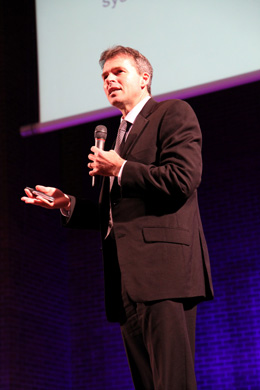Candid celebration affirms creation
Brenton Stacey
Public relations officer
Avondale College of Higher Education
Cooranbong, New South Wales, Australia
Administrators, scientists and theologians affirmed the Seventh-day Adventist Church’s belief in biblical creation during a surprisingly candid Celebration of Creation at Avondale College of Higher Education, May 13 and 14.

Scientist speaks: Paleontologist Dr Raúl Esperante noted the increasing acceptance of catastrophism in geology. Credit: Timothy Standish.
Avondale president Dr Ray Roennfeldt used his welcome on Friday evening to remind us God is the focus of creation. Genesis 1 and 2 “challenges every other god of this world,” he said. “Nothing is to be worshipped. Not the trees, not the animals, not the rocks, not the sun, or moon or the stars . . . no human being—they’re all created.”
Friday evening
Dr Jim Gibson, director of the church’s Geoscience Research Institute, opened the Friday evening meetings by identifying three commonly held worldviews—biblical theism, which regards God as the creator and ruler of the universe; materialism, which regards matter and its motions as constituting the universe, and all phenomena, including those of mind, as due to material agencies; and pantheism, which identifies the universe with God. He then identified three points in the biblical creation that fit naturally with the Adventist worldview—creation by an authoritative decree in six days, special creation of humans and a good creation corrupted by sin—and noted the contradictions between these and the evolutionary theories associated with materialism and pantheism.
Dr Grenville Kent, lecturer in Old Testament and arts in the School of Theology at Wesley Institute and producer for the church in Australia of a documentary series called Big Questions, spoke of the importance of speech in what he described as one of the creation psalms (Psalm 19). The heavens speak (verses 1-6), God speaks through the Torah (7-9) and then the writer, David, speaks to God (10-14). However, because of the fall, nature no longer speaks clearly, he added, before noting the gospel is about the redeeming of nature. His point: we let nature interpret the Bible, or we let the Bible interpret nature.
Saturday morning
Dr Barry Oliver, president of the church in the South Pacific, preached the sermon during the worship service in Avondale College Seventh-day Adventist Church on Saturday morning. He began by asking three questions: “Does the Bible affirm God as creator?” “Does the Bible affirm God as re-creator?” and “What is special about how Seventh-day Adventists relate to God as creator and re-creator?” Using a variety of Bible texts, including the first of the three angels’s message of Revelation 14, Barry showed the intrinsic relationship of creation, salvation and worship to answer yes to the first two questions. The answer to the third: we celebrate God as creator and re-creator by honouring the time—the Sabbath—He created for the purpose.
Saturday afternoon

Scientist speaks: Biochemist Dr Ross Grant asserted that mutation cannot create a single gene within the human evolutionary time scale. Credit: Timothy Standish.
Dr Gerhard Pfandl, associate director of the church’s Biblical Research Institute, identified three Adventist interpretations of Genesis 1 and 2 during the opening Saturday afternoon meeting. The first interpretation, a two-stage creation, interprets Genesis 1:1 as referring to the creation of much of the universe a long time ago and then to the creation of life within the creation week. The second, a literal, six-day creation, interprets the same text as referring to the creation of everything, including the universe, within the creation week. The third, theistic evolution, interprets the text metaphorically. Gerhard noted Moses as not writing scientifically but phenomenologically.
The following speaker, Dr Timothy Standish, a molecular biologist who serves as a research scientist at the Geoscience Research Institute, identified problems with evolutionary fossil theory. He spoke of “Lazarus” species such as the Wollemi pine, the sophisticated compound lenses in the eyes of trilobites, which are among the earliest known fossils and have no known evolutionary history, and vertebrates in Cambrian layers. While noting many mysteries remained, he described fossils as appearing to have been well designed, just as do modern organisms.
Paleontologist Dr Raúl Esperante, a colleague of Timothy’s, noted the increasing acceptance of catastrophism, which attributes certain vast changes in the earth’s history as being caused by catastrophes rather than gradual evolutionary processes, in geology. Science recognised catastrophism could result in deposits, often containing extensive fossil beds, of up to 800,000 square kilometres, he said, adding the beds display little evidence of erosion.
Other presenters included biochemist Dr Ross Grant, executive officer of the church’s Australasian Research Institute, who asserted that mutation cannot create a single gene within the human evolutionary time scale, and Dr David Tasker, field secretary for the church in the South Pacific, who noted how the flood reverses creation, as the things that were separated out of the Earth came together again.
The Celebration of Creation ended with a panel answering questions sent electronically by those attending. The response to, “I don’t believe in a literal, six-day creation. Do I belong in this church?” summarised the weekend. You do belong, said Dr Delbert Baker, a vice-president of the worldwide church. We accept you, but we expect you not to promote views counter to the church’s position.
Celebration series
Celebration of Creation is one of a series sponsored by the worldwide church’s Faith and Science Council. The Avondale celebration is only the second held outside of the United States—Pacific Adventist University (Port Moresby, Papua New Guinea) held the first the previous weekend. The church has held others at Loma Linda University (California) in 2009 and at Andrews University (Berrien Springs, Michigan) in 2010.—with Kent Kingston, assistant editor, News and Editorial, Adventist Media Network
